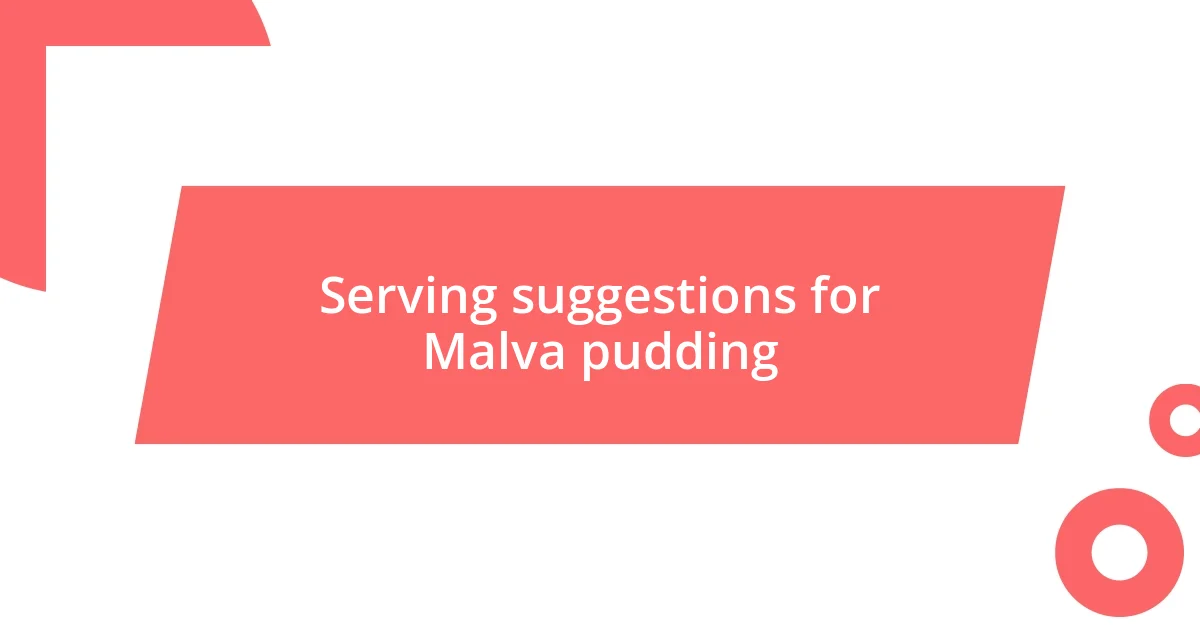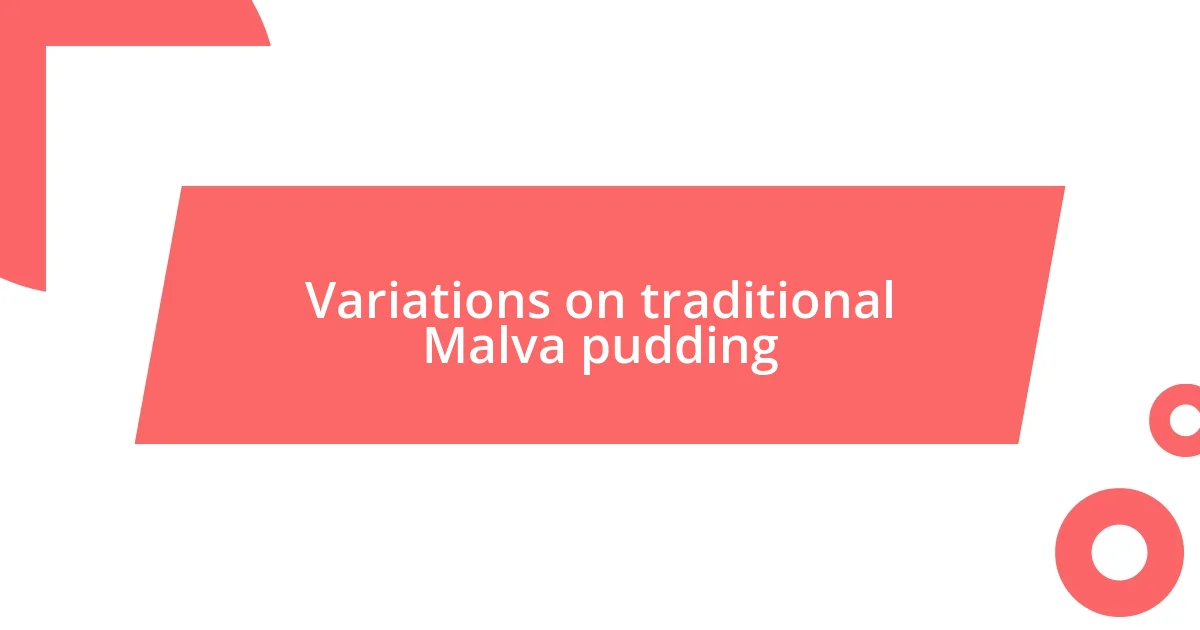Key takeaways:
- Malva pudding, a traditional South African dessert, evokes feelings of home and togetherness, created with simple ingredients like flour, sugar, and apricot jam.
- Key techniques for perfecting Malva pudding include whisking eggs until frothy, careful baking time to prevent dryness, and pouring hot buttery sauce right before serving.
- Variations like coconut Malva pudding and adding seasonal fruits or spices enhance the classic recipe, allowing for creative twists while maintaining its comforting essence.

Understanding Malva pudding
Malva pudding is more than just a dessert; it’s a warm, comforting hug on a chilly evening. I still remember the first time I tasted it at a family gathering. The rich, sweet aroma filled the room, and with the first bite, the sticky and moist texture enveloped my taste buds—pure bliss! Have you ever experienced a dish that instantly felt like home? That’s what Malva pudding did for me.
At its core, this traditional South African pudding is made with simple ingredients like flour, sugar, eggs, and apricot jam, which surprisingly brings a delightful depth of flavor. This combination creates a unique, spongy sweetness that’s further elevated by the warm, buttery sauce drizzled on top. If you’ve ever wondered how such simple components can create something so special, you’re not alone! It’s all about the balance and the way they come together in perfect harmony.
What I find fascinating is that Malva pudding is steeped in a rich history, often associated with South African gatherings and celebrations. Whether served at Sunday lunches or festive occasions, this pudding is a reminder of togetherness and shared moments. I often think about the laughter and stories shared over dessert with loved ones—how can a dish evoke such treasured memories? That’s the magic of Malva pudding; it’s not just food; it’s an experience.

Key ingredients for Malva pudding
When it comes to crafting the perfect Malva pudding, the key ingredients play a pivotal role in creating that signature flavor and texture. Personally, I’ve found that each component contributes its own unique touch, making the pudding an unforgettable delight. The combination of sugar and apricot jam is especially magical; the jam not only sweetens the dish but also imparts a fruity essence that keeps every bite interesting.
Here’s a closer look at the essential ingredients:
- All-purpose flour: Provides the structure.
- Brown sugar: Adds a rich sweetness and depth.
- Eggs: Contribute to a light, airy texture.
- Milk: Ensures moisture, making the pudding indulgently soft.
- Apricot jam: Gives a hint of fruitiness and enhances overall flavor.
- Baking soda: Acts as a leavening agent for that airy lift.
- Butter: Enriches the pudding with a luxurious taste.
One of my fondest memories is baking this treat with my grandmother, who always emphasized the importance of using real butter. She insisted that it made all the difference in flavor. Our kitchen would fill with the warm, inviting scent, and I couldn’t help but sneak spoonfuls of the batter, savoring the sweetness as we prepared for family gatherings. It’s incredible how these simple ingredients can evoke such warmth and joy, reminding us that sometimes, the best recipes hold more than just flavors; they hold stories and connections that linger long after the last slice has been enjoyed.

Perfecting the Malva pudding texture
Perfecting the Malva pudding texture requires a careful balance of ingredients and technique. One of my go-to tips is to whisk the eggs until frothy before incorporating them into the mix. This technique introduces air, making the pudding light and airy, which contrasts beautifully with its rich sauce. I still remember the joy of watching my pudding rise perfectly in the oven, a sight that always brings a smile to my face.
In my experience, the key to achieving that coveted sticky texture lies in the baking time. Overbaking can lead to a dry outcome, stripping away the gooey indulgence we all love. I suggest checking for doneness a few minutes earlier than the recipe states. Ideally, a toothpick should emerge with a few moist crumbs, which tells you it’s ready for its sweet, buttery sauce. I can’t help but recall the time I pulled a slightly under-baked malva pudding from the oven—it turned out to be the softest, most delectable version I’ve ever made!
Another delightful aspect of mastering this dessert is the warmth of the sauce. Pouring that hot, buttery mixture over the baked pudding right before serving allows it to soak in just the right amount. I urge you to resist the temptation to skimp on this step! It’s like adding the final brush stroke to a beloved painting, enhancing not only the flavor but also that irresistibly soft and sticky texture. Every bite should feel like a warm hug; don’t you agree?
| Aspect | Tip |
|---|---|
| Egg Whisking | Whisk eggs until frothy to introduce air. |
| Baking Time | Check for doneness early to avoid drying. |
| Sauce Application | Pour hot sauce right before serving for maximum soak. |

Essential cooking techniques for flavor
One essential technique I’ve mastered over the years is gently folding the dry ingredients into the wet. This method ensures that the batter remains airy and light, which is crucial for the final texture of Malva pudding. I remember the first time I tried to mix them aggressively—let’s just say the result was less than appetizing! It’s a small change, but one that can drastically elevate the outcome. Have you ever noticed how the gentlest touches often yield the most delightful results?
Another technique I can’t stress enough is to preheat the oven properly. It might seem straightforward, but starting with a hot oven not only promotes even baking but also helps that beautiful, golden top form. I’ve had moments where I forgot this step and ended up with a pudding that looked more like a pancake—definitely a learning experience! So, make it a habit to give your oven plenty of time to reach the desired temperature; it’s worth it.
Lastly, speaking of adding flavor, the temperature of your butter matters too. I like to melt my butter until it’s just warm rather than hot. I find that this helps integrate the flavors more effectively without cooking the eggs too quickly when mixed in. Have you ever tasted a dessert that felt flat, even though the recipe called for the right ingredients? That’s often due to these little nuances. Trust me, treating your ingredients with care can lead to mouthwatering results that will leave everyone asking for seconds!

Top tips for rich sauce
When it comes to crafting a rich sauce for your Malva pudding, I’ve found that the blend of pantry staples makes all the difference. I love using a combination of heavy cream and butter for that decadent mouthfeel—it truly elevates the experience. One time, I used a little less butter, thinking it wouldn’t matter, and the sauce lacked that lush, silky quality. It was a lesson learned: never underestimate the power of rich, quality ingredients!
As I’ve experimented, I’ve discovered that the slower you heat your sauce, the better it gets. Gently warming the mixture allows the flavors to meld beautifully, creating that inviting aroma that fills your kitchen. I never forget the moment I stood at the stove, stirring a warm vanilla and butter concoction, and the rich scent wrapped around me like a comforting blanket. Have you ever imagined how fantastic it is when that first drizzle of sauce cascades over the pudding, inviting all those flavors to mingle?
Moreover, don’t shy away from adding a splash of something unexpected like brandy or orange zest. These tiny increments make a huge impact. I remember the first time I added a bit of almond essence—it transformed my sauce into something extraordinary. It was as if I had discovered a hidden gem! I encourage you to experiment with flavors that resonate with you; you’ll likely find that your personal touch leads to a sauce that’s unforgettable. Don’t you want every bite to hold the promise of delight?

Serving suggestions for Malva pudding
Malva pudding shines brightest when it’s served warm. Personally, I love to present it straight from the oven, steam still rising, accompanied by a generous drizzle of that rich sauce I’ve perfected. I always remember the look on my guests’ faces as they catch a whiff of the warm butter and vanilla wafting through the air—it’s pure magic. Have you ever noticed how the warmth of a dessert invites everyone in?
For an added touch of indulgence, I recommend serving Malva pudding with a scoop of vanilla ice cream or a dollop of whipped cream. The contrast between the warm pudding and cold cream creates a symphony of textures that’s simply irresistible. I once had a friend describe it as “the most comforting hug,” and I couldn’t agree more. Don’t you think that’s what dessert should be all about—comfort and joy?
Adding a sprinkle of toasted nuts or fresh fruit can elevate it even further. I enjoy placing some toasted almonds on top for that delightful crunch. I vividly remember a gathering where the guests were initially hesitant about the nuts, but after one bite, they were reaching for more. It’s the little touches, like a burst of freshness or unexpected texture, that can transform a beloved classic into something truly extraordinary, don’t you think?

Variations on traditional Malva pudding
One delightful variation I’ve experimented with is coconut Malva pudding. By swapping out some of the traditional milk for coconut milk and adding shredded coconut to the batter, you create a tropical twist that’s truly refreshing. I fondly recall a summer gathering where I served this variation, and the guests couldn’t get enough of that hint of island flavor. Have you ever thought about how a simple change can transport you to a whole new foodie experience?
Another interesting take is to incorporate seasonal fruits into the pudding itself. I’ve enjoyed blending in ripe, mashed bananas or even pockets of tart berries. The result is not just a flavor surprise, but also a delightful textural contrast. I still remember how the first time I added berries, they bursted with juice, offering a tangy balance to the sweetness. Isn’t it amazing how nature can guide our culinary creativity?
For those who crave a bit of spice, adding a touch of cardamom or cinnamon into the mix can amplify the pudding’s warmth and depth. I vividly remember the cozy evening when I decided to experiment with cardamom; it was like wrapping myself in a fragrant shawl! These spices transform a familiar dessert into something that feels both exotic and comforting. Don’t you think that’s the beauty of cooking—finding ways to make something feel new while still holding onto its comforting roots?














